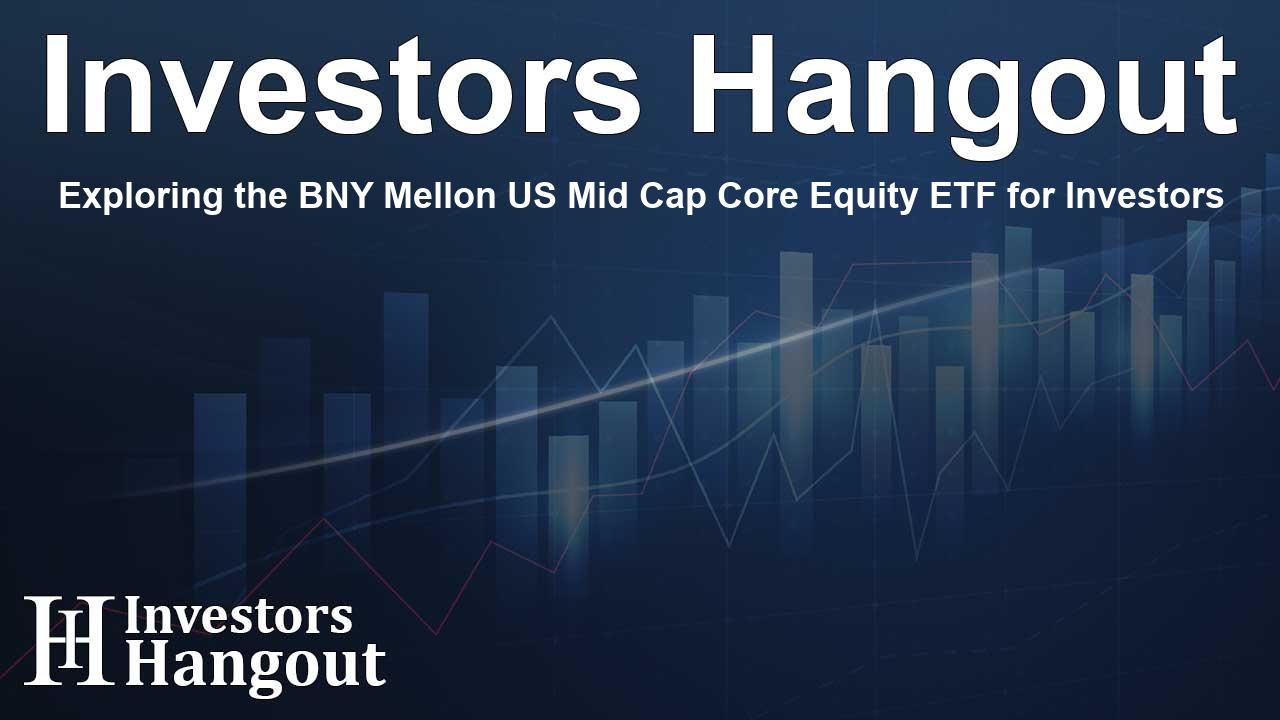Exploring the BNY Mellon US Mid Cap Core Equity ETF for Investors

Overview of the BNY Mellon US Mid Cap Core Equity ETF
The BNY Mellon US Mid Cap Core Equity ETF (BKMC) is designed to provide investors with extensive exposure to the Mid Cap Blend segment of the US equity market. Launched in April 2020, this passively managed exchange-traded fund has quickly gained attention due to its significant assets, totaling over $495.10 million, indicating a robust interest and trust from investors.
Understanding Mid Cap Investments
Investing in mid-cap companies, defined as those with market capitalizations between $2 billion and $10 billion, offers a unique blend of growth potential and stability. These companies often present higher growth prospects than their larger counterparts, while being less volatile than smaller firms. This makes mid-cap investments appealing for those seeking a balanced approach to risk and reward.
Characteristics of Blend ETFs
The term “Blend” is used because these ETFs typically include a mix of growth and value stocks. This combination allows for diversification within the portfolio, as it can capture various market movements and trends.
Cost Efficiency and Expenses
Another significant factor for investors is the expense ratio. The BNY Mellon US Mid Cap Core Equity ETF boasts an impressively low annual operating cost of just 0.04%. Lower expenses generally contribute to better investment performance in the long term, making this ETF an attractive candidate for cost-conscious investors.
Sector Distribution and Key Holdings
Diversification is crucial when investing in ETFs, as it helps reduce the risk associated with individual stocks. Notably, this ETF has its highest allocation of approximately 26.60% in the Industrials sector, followed closely by Consumer Discretionary and Healthcare sectors.
Among its top holdings, the ETF features Godaddy Inc - Class A (GDDY), which makes up about 0.64% of total assets. Other significant holdings include Leidos Holdings Inc (LDOS) and Texas Pacific Land Corp (TPL). Together, the top ten holdings account for roughly 5.48% of the total assets under management, illustrating a well-rounded investment strategy.
Performance Metrics and Risk Assessment
The primary objective of BKMC is to mirror the performance of the Morningstar U.S. Mid Cap Index, which evaluates medium-capitalization stocks. So far this year, BKMC has realized approximately 9.48% growth and has achieved a commendable increase of about 21.08% over the last year. Over the past 52 weeks, the ETF has fluctuated between a low of $75.04 and a high of $99.80.
With a beta of 1.02 and a standard deviation of 19.22% over the trailing three-year period, BKMC effectively mitigates company-specific risks through its diverse portfolio of around 407 holdings.
Considering Alternatives
With a Zacks ETF Rank of 3 (Hold), the BNY Mellon US Mid Cap Core Equity ETF is suitable for investors looking to gain exposure to the mid-cap blend market. However, those exploring further options may consider alternatives like the Vanguard Mid-Cap ETF (VO) and the iShares Core S&P Mid-Cap ETF (IJH). The Vanguard ETF manages about $67.95 billion in assets and has an expense ratio of 0.04%, while the iShares fund maintains $88.17 billion in assets with a slightly higher expense ratio of 0.05%.
Conclusion: A Strong Addition to Portfolios
Passively managed ETFs like BKMC continue to enjoy growing popularity among both institutional and retail investors. Their low costs, transparency, and potential for significant long-term gains make them an excellent choice for a wide range of investment strategies. As always, it’s essential to assess your own financial goals and risk tolerance before making investment decisions.
Frequently Asked Questions
What is the primary investment focus of the BKMC ETF?
The BKMC ETF primarily focuses on mid-cap blend stocks in the US equity market, offering a mix of growth and value investment opportunities.
How does BKMC's expense ratio compare to other ETFs?
With an expense ratio of 0.04%, BKMC is one of the least expensive ETFs, which can lead to better long-term performance compared to higher-cost options.
What sectors does the BNY Mellon US Mid Cap Core Equity ETF emphasize?
The ETF has its largest allocation in the Industrials sector, which accounts for about 26.60% of its holdings, along with significant investments in Consumer Discretionary and Healthcare sectors.
How has BKMC performed recently?
This ETF has gained around 9.48% this year and approximately 21.08% over the past year, demonstrating strong recent performance.
Are there similar ETFs to consider?
Yes, investors can consider the Vanguard Mid-Cap ETF (VO) and the iShares Core S&P Mid-Cap ETF (IJH) as they track similar indices and offer competitive options in the mid-cap space.
About The Author
Contact Caleb Price privately here. Or send an email with ATTN: Caleb Price as the subject to contact@investorshangout.com.
About Investors Hangout
Investors Hangout is a leading online stock forum for financial discussion and learning, offering a wide range of free tools and resources. It draws in traders of all levels, who exchange market knowledge, investigate trading tactics, and keep an eye on industry developments in real time. Featuring financial articles, stock message boards, quotes, charts, company profiles, and live news updates. Through cooperative learning and a wealth of informational resources, it helps users from novices creating their first portfolios to experts honing their techniques. Join Investors Hangout today: https://investorshangout.com/
The content of this article is based on factual, publicly available information and does not represent legal, financial, or investment advice. Investors Hangout does not offer financial advice, and the author is not a licensed financial advisor. Consult a qualified advisor before making any financial or investment decisions based on this article. This article should not be considered advice to purchase, sell, or hold any securities or other investments. If any of the material provided here is inaccurate, please contact us for corrections.
